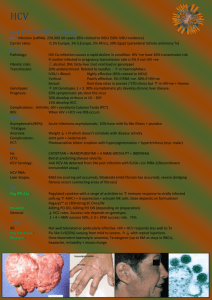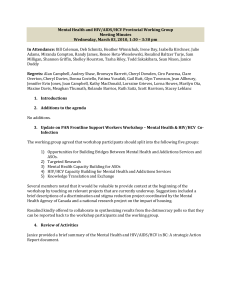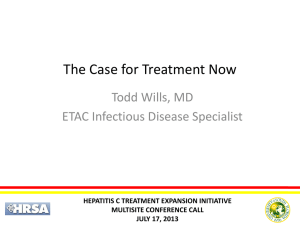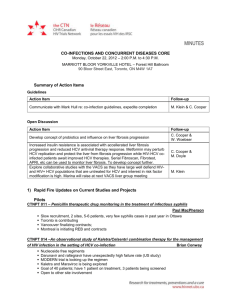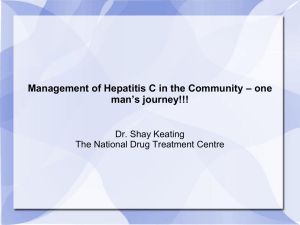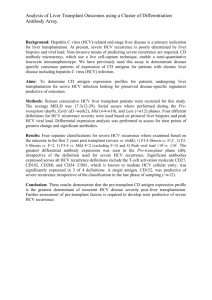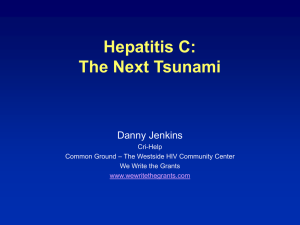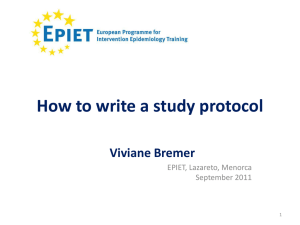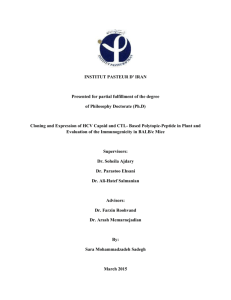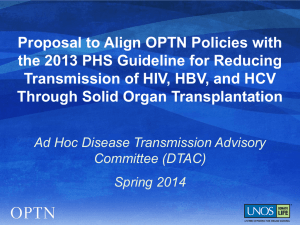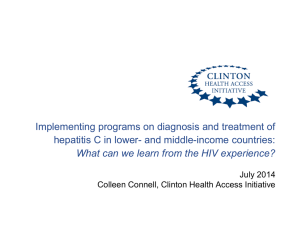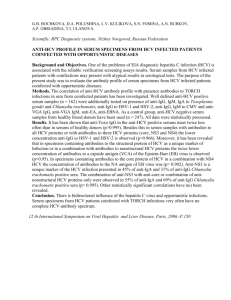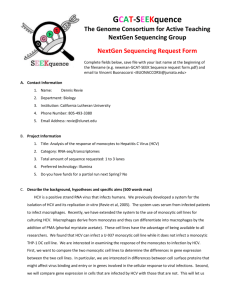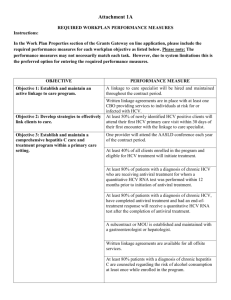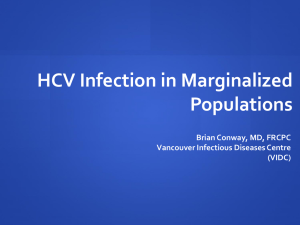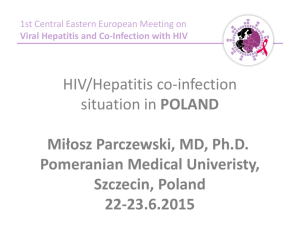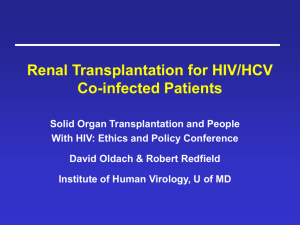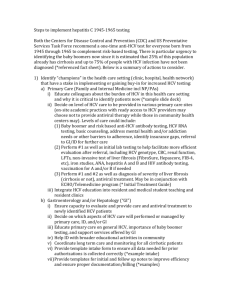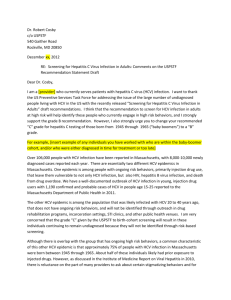The Association of HIV and HCV Co-Infection with Cardiometabolic
advertisement
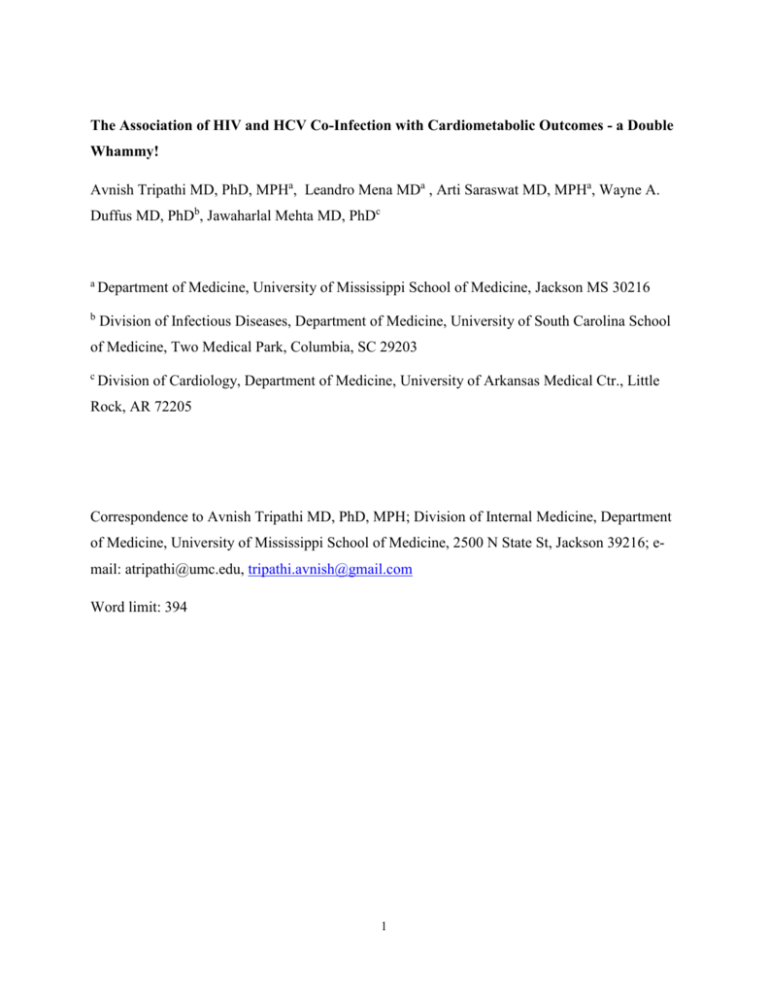
The Association of HIV and HCV Co-Infection with Cardiometabolic Outcomes - a Double Whammy! Avnish Tripathi MD, PhD, MPHa, Leandro Mena MDa , Arti Saraswat MD, MPHa, Wayne A. Duffus MD, PhDb, Jawaharlal Mehta MD, PhDc a Department of Medicine, University of Mississippi School of Medicine, Jackson MS 30216 b Division of Infectious Diseases, Department of Medicine, University of South Carolina School of Medicine, Two Medical Park, Columbia, SC 29203 c Division of Cardiology, Department of Medicine, University of Arkansas Medical Ctr., Little Rock, AR 72205 Correspondence to Avnish Tripathi MD, PhD, MPH; Division of Internal Medicine, Department of Medicine, University of Mississippi School of Medicine, 2500 N State St, Jackson 39216; email: atripathi@umc.edu, tripathi.avnish@gmail.com Word limit: 394 1 Background Reports on the effect of hepatitis C viral (HCV) infection on development of cardiometabolic diseases has been conflicting. Chronic inflammation caused by HCV could accelerate the atherosclerotic process. By contrast, studies have suggested lower risk of dyslipidemia and decreased C-reactive protein levels associated with chronic HCV infection which may confer a possible protective effect against cardiometabolic diseases. The literature remains scarce on the impact of HCV co-infection with HIV in development of cardiometabolic diseases. We evaluated the association of HCV with incidence of dyslipidemia, diabetes, and acute cardiocerebrovascular (CVD) events in a matched cohort of HIV and non-HIV infected persons. Methods The study cohort included 1:1 propensity score matched cohort of HIV-infected and non-HIVinfected individuals, >18 years old, who were served through the South Carolina Medicaid during 1994 – 2011. Pharmacy claims and diagnosis/procedure ICD-9 codes per visit were used to define clinical variables. Cumulative CVD event included incident myocardial infarction, angina pectoris, coronary interventions, ischemic stroke. Time-dependent Cox proportional hazards analysis was used to examine the data. Each model was adjusted for gender, race, age, year of enrollment, total months of follow-up, smoking, and hepatitis B infection; and timedependent pertinent risk factors including hypertension, diabetes, dyslipidemia, and obesity. Results 13,632 (6816 cases and controls) study cohort contributed a total of 88,359 person-years (PY) of follow-up. The median age of the study cohort was 39 years (interquartile range [IQR]: 31-46 years) and the majority were men (57%) and African American (71%). HCV infection was present in 927 (13.6%) and 187 (2.7%) among HIV-infected and non-infected controls respectively. Unadjusted incidence density rates among those with HIV and HCV co-infection as compared to non-HIV/non-HCV control group was lower for dyslipidemia (23 versus 25 per 1000 PY); higher for diabetes (19 versus 15 per 1000 PY); and higher for CVD events (31 versus 22 per 1000 PY). Compared to non-HIV/non-HCV control group the time-dependent survival analysis suggested significantly increased risk of diabetes in HIV and HCV co-infection (adjusted hazards ratio [aHR] 1.468; 95% confidence interval [CI] 1.13-1.91); and significantly increased risk of cumulative CVD events (aHR 1.452; 95% CI (1.19-1.78). Results also suggested increased risk of CVD among controls with HCV compared to those without (aHR 1.52; 95% CI 1.04-2.23). Conclusions Our results suggest HIV and HCV co-infection associated with significantly increased risk of developing diabetes and CVD events as compared to HIV alone and non-HIV/non-HCV controls. 2
